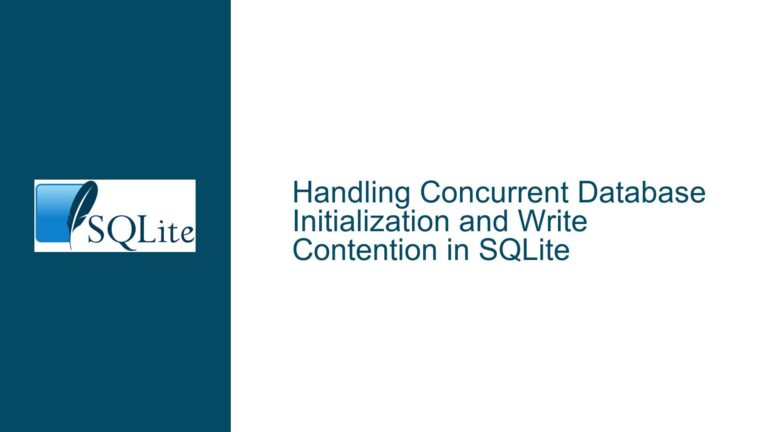Optimizing Large SQLite Database Rebuilds: Dump, Insert, and VACUUM INTO Strategies
Understanding the Performance Bottlenecks of VACUUM on Large Databases
When dealing with large SQLite databases, particularly those in the hundreds of gigabytes range, the VACUUM command can become a significant bottleneck. The VACUUM operation is designed to rebuild the database file, reclaiming unused space and defragmenting the data to improve performance. However, this process involves creating a temporary copy of the entire database, which can be extremely time-consuming for large datasets. In the case of a 660GB database, the original poster reported that a standard VACUUM operation took over 72 hours without completion. This highlights a critical limitation of VACUUM when applied to very large databases: its linear time complexity and reliance on disk I/O operations.
The primary issue with VACUUM in this context is its internal mechanism. During a VACUUM, SQLite reads the entire database, writes it to a temporary file, and then replaces the original file with the temporary one. This process is inherently slow because it involves extensive disk reads and writes, especially when the database is fragmented or contains many deleted rows. Additionally, the Write-Ahead Logging (WAL) mode, while beneficial for concurrency and performance in many scenarios, can exacerbate the slowness of VACUUM due to the additional overhead of managing the WAL file.
The original poster’s question about dumping and reinserting data as an alternative to VACUUM is rooted in the desire to avoid these bottlenecks. By manually reconstructing the database, it might be possible to achieve the same benefits as VACUUM—such as defragmentation and space reclamation—while potentially reducing the time required. However, this approach introduces its own set of challenges, such as ensuring data integrity, managing indexes efficiently, and minimizing downtime during the rebuild process.
Exploring the Trade-offs Between VACUUM, VACUUM INTO, and Manual Rebuilds
The discussion highlights three primary methods for optimizing large SQLite databases: the standard VACUUM command, the VACUUM INTO command, and a manual rebuild process involving dumping and reinserting data. Each method has its own advantages and trade-offs, which must be carefully considered based on the specific use case.
The standard VACUUM command is the most straightforward approach but is often impractical for very large databases due to its slow performance. As demonstrated in the discussion, a 660GB database took over 72 hours to process with VACUUM, making it unsuitable for time-sensitive operations.
The VACUUM INTO command, suggested by Adrian Ho, offers a significant improvement over the standard VACUUM. Instead of overwriting the original database file, VACUUM INTO writes the rebuilt database to a new file. This approach has several advantages. First, it allows the original database to remain accessible during the vacuuming process, reducing downtime. Second, it can be faster because it avoids some of the overhead associated with modifying the original file. In the discussion, the original poster reported that VACUUM INTO completed in just 23 hours, compared to the unfinished 72-hour VACUUM. This makes VACUUM INTO a compelling alternative for large databases.
The manual rebuild process, as described by Simon Slavin, involves dumping the data to a text file, creating a new database, and reinserting the data. This method can be even faster than VACUUM INTO if done correctly. The key to its efficiency lies in the order of operations: creating indexes after inserting the data, rather than before. Indexes are expensive to maintain during bulk inserts, so deferring their creation until after the data is loaded can significantly reduce the time required. Additionally, setting the journal_mode to OFF during the rebuild process eliminates the overhead of journaling, further speeding up the operation.
However, the manual rebuild process is more complex and error-prone than using VACUUM or VACUUM INTO. It requires careful scripting to ensure data integrity and may involve additional steps, such as backing up the original database and verifying the new database’s consistency. Despite these challenges, the potential performance gains make it a viable option for very large databases where time is a critical factor.
Step-by-Step Guide to Optimizing Large SQLite Databases
To address the performance issues associated with VACUUM on large databases, here is a detailed guide to implementing the most effective strategies: using VACUUM INTO and performing a manual rebuild.
Using VACUUM INTO for Faster Database Rebuilds
Assess the Database Size and Fragmentation: Before proceeding, determine the size of your database and the extent of fragmentation. Tools like
sqlite3_analyzercan provide insights into the database’s structure and help identify areas that would benefit from optimization.Execute VACUUM INTO: Run the
VACUUM INTOcommand to create a new, optimized database file. For example:VACUUM INTO 'optimized_db.sqlite';This command will rebuild the database and write the result to
optimized_db.sqlite.Verify the New Database: After the
VACUUM INTOoperation completes, verify the integrity of the new database using thePRAGMA integrity_checkcommand. This ensures that the rebuild process did not introduce any errors.Replace the Original Database: Once the new database has been verified, replace the original database file with the optimized version. Ensure that any applications using the database are stopped during this step to avoid conflicts.
Re-enable WAL Mode (if necessary): If your database was using WAL mode before the
VACUUM INTOoperation, re-enable it on the new database:PRAGMA journal_mode=WAL;
Performing a Manual Rebuild for Maximum Performance
Dump the Data to a Text File: Use the
.dumpcommand in the SQLite command-line interface to export the database schema and data to a text file:sqlite3 original_db.sqlite .dump > dump.sqlCreate a New Database: Create a new, empty database file:
sqlite3 new_db.sqliteDisable Journaling: To maximize performance during the rebuild, disable journaling:
PRAGMA journal_mode=OFF;Import the Data: Import the data from the dump file into the new database. If your dump file includes schema definitions, you may need to modify it to defer index creation until after the data is inserted. For example, you can manually create the tables, insert the data, and then create the indexes:
-- Create tables CREATE TABLE ...; -- Insert data INSERT INTO ...; -- Create indexes CREATE INDEX ...;Re-enable Journaling: After the data has been imported and indexes have been created, re-enable journaling if necessary:
PRAGMA journal_mode=WAL;Verify the New Database: Perform a final integrity check using
PRAGMA integrity_checkto ensure the new database is consistent and error-free.Replace the Original Database: Replace the original database file with the newly optimized version, ensuring that applications are stopped during the transition.
By following these steps, you can significantly reduce the time required to optimize large SQLite databases while maintaining data integrity and minimizing downtime. Whether you choose to use VACUUM INTO or perform a manual rebuild, these strategies provide a robust framework for handling large-scale database optimization tasks.






